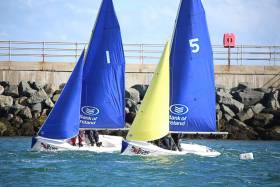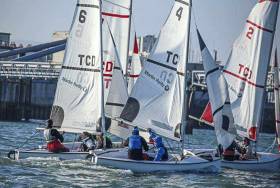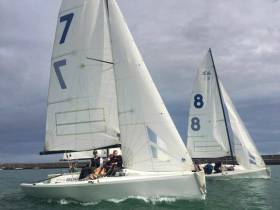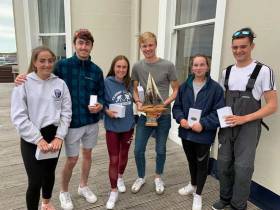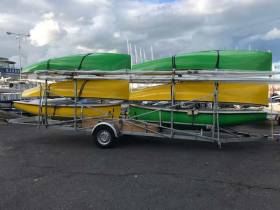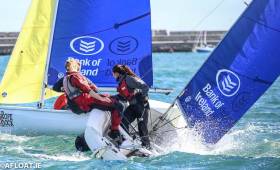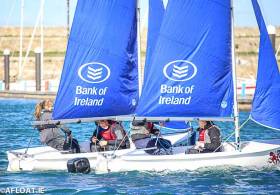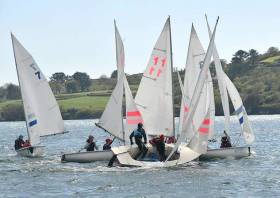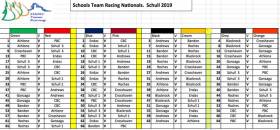Displaying items by tag: Team Racing
UCD Sailing Club Host 'Movember' Team Racing Event at Royal Irish Yacht Club
This Saturday 30th of November, UCD Sailing Club are running a charity team racing event in aid of the Movember Foundation.
Teams have been going head to head throughout the past month seeing who can grow the best moustache, and they will continue to battle it out on the water during the racing. The participants will spend the last few hours with their furry friends on the water, and on recovery, we will have a ceremonial shaving.
There will be free tea and coffee all day for UCD, kindly provided by the Royal Irish Yacht Club. After racing there will be mince pies and mulled wine waiting inside, for a celebration for the freshly shaved faces.
If you know anyone who would be interested in entering a team in this event, or can be of any help sponsoring prizes, please email [email protected]. If November sailing isn’t for you, we also have a donation link for our team and we really appreciate all donations here
Baltimore Sailing Club Claim National Team Racing Title at Royal St. George Yacht Club
The Royal St George Yacht Club hosted 16 teams at the 71st National Team Racing Championships last weekend in Dun Laoghaire.
Near perfect team racing conditions of 8-12 knots breeze allowed a full round-robin competition of 120 races to be sailed. Each team completed 15 races against their opponents. Baltimore SC conceded one loss to Not Fast Just Furious and Royal St George Knights conceded to Baltimore SC who both emerged on top with 14 wins apiece. In their wake were’ Not Fast Just Furious’ on 13 wins and Howth YC and Poppa J and Hoochie Men on 10 wins apiece.
HYC won the tie on lowest points to qualify for the Semi Finals against Baltimore. Not Fast Just Furious faced the George Knights in the other semi-final leg. Time was limited by the sailing instructions and consent had to be sought from the leading two teams to permit a semi final after 3pm: sportingly both Baltimore and the Knights agreed. Surprisingly ‘Fast not Furious’ overturned the Knights 2-0 to face Baltimore who despatched Howth 2-0; all races were fought frenetically with the umpire team fully engaged in sorting out the flurry of flags during racing.
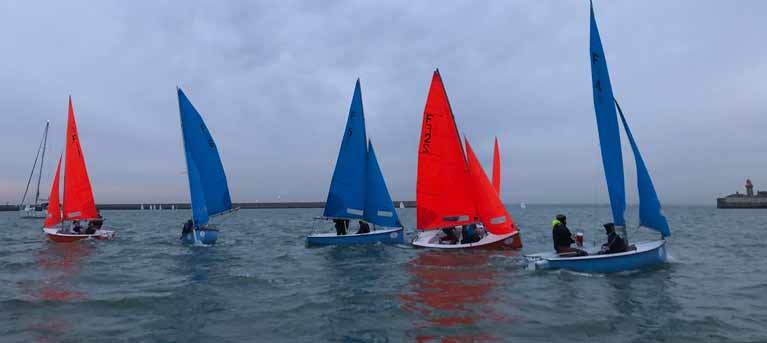 Near perfect team racing conditions of 8-12 knots breeze allowed a full round-robin competition of 120 races to be sailed
Near perfect team racing conditions of 8-12 knots breeze allowed a full round-robin competition of 120 races to be sailed
‘Fast and Furious’ were true to their moniker but calm and collected the Baltimore team comprising Mark Hassett with Adam Hyland, Fionn Lyden with Amy Harrington and Johnny Durcan with Trudy O’Hara controlled the races from the starts and systematically ground their opponents back to convincingly claim the title 3-0 in the final races. Fast not Furious comprised Finn Lynch, Liam Glynn, Conor O'Beirne, Cora McDowell, Sally Bell and Graine Young...... George Knights comprised John Sheehy with Rachel McManus, Nick Smyth with Jodie Jane Tingle, and Gerald Owens with Melanie Morris. The Knights despatched Howth YC in the petit final to claim the bronze medals. H.Y.C. Simon Rattigan, Lynn Reilly, Darragh O'Connor, Kerrie O'Leary, Aidan McLaverty & Jenny Andreason. The Youth division was won by RCYC Lola! Lola kohl, Eva Spillane, Justin Lucas, Killian Oregan, Rory O'Sullivan & Rob Keal
Results are downloadable below.
Demand for Team Racing Increases - Irish Sailing
Irish Sailing’s Team Racing Programme is well underway with interest building across the country at clubs and centres each looking for bespoke training for instructors and sailors of all ages and abilities writes Gail McAllister
Team Racing is a fun and inexpensive way for clubs to retain young dinghy sailors after they have left the structured environs of class youth racing or the Irish Sailing Training Schemes. With a focus on rules knowledge, boat handling, tactics and teambuilding, the programme will further develop transferable skills and give rise to skilled and competitive racing in a very sociable environment.
The BIM FLAG funded initiative (Bord Iascaigh Mhara Fisheries Local Area Group Development), organised by Irish Sailing’s Team Racing Contractor and delivered by experienced Club Race Coaches is gaining traction following the successful delivery of Irish Sailing’s mid-term team racing clinics and demand is increasing.
Clubs getting involved
Last Wednesday, 22 sailors, ranging in ages from 11 to 16 turned out at Royal Irish Yacht Club for their first junior team racing clinic in RS Fevas. Unfortunately, on-water coaching was abandoned due to high winds, but team racing coach Greg Arrowsmith delivered a great interactive shore-based workshop introducing the team racing format, rules and tactics with the aid of video and games to keep the sailors interested and engaged. The RIYC offer a great setup for young people new to team racing or want to improve their sailing and are aiming to deliver further team racing clinics and a regular programme.
The Royal St George Yacht Club enjoyed an intensive two-day clinic with a group of improvers. As the wind abated, the group were able to get afloat on both days applying tactics and team racing manoeuvres. There was great sailor engagement and a huge improvement throughout the two days
Cork Boat Club in Blackrock are a fledgeling club with a fleet of Fireflys who race on the River Lee. Team Racing Coach Noah McCarthy visited last Sunday to provide a seminar on rules and tactics
Malahide Yacht Club has booked a clinic for mid November using their fleet of Topaz and Feva dinghies with club instructors shadowing Irish Sailing team racing coaches Aaron Jones and Noah McCarthy as part of their continuous professional development.
Umpires Courses
This weekend sees the first Local Umpires Course which is now fully booked with 14 participants. The course will be delivered by International Umpires Cxema Pico and Chris Lindsay and participants will have a great opportunity to practice their newly learnt skills on the Trinity Alumni event at Royal St George Yacht Club. A further local umpires course is planned for early 2020.
Rolling out around the country
Irish Sailing have also received interest from clubs including Spiddal, Glandore, Baltimore, Waterford, Rush, Wicklow, Sligo, Galway Bay, Dublin Bay, Sutton, Malahide, Killaloe and Carlingford. With a new fleet of Fireflys due to arrive by the end of November the Irish Sailing Roadshow will be rolled out further over coming months.
Clubs and training centres wishing to be part of the programme can avail of free team racing coaching in existing club boats. In the absence of existing matched club boats, the team racing contractor and coaches can visit your club with a fleet of Fireflys for a small charge to cover transport, damage deposit and expenses. The fleet are to be delivered later this month.
To register your club’s interest in the roadshow, please contact Rory Martin for more information [email protected]
National Yacht Club's New Elliot Keelboat Fleet Get 2K Team Racing Test
The National Yacht Club’s new fleet of Elliot 6 high-performance keelboats were in action last weekend in Dun Laoghaire for a 2K team racing invitational writes Roisin O'Brien
30 sailors took to the water in Dun Laoghaire Harbour for the day, including teams from The National Yacht Club (U30 and U25 teams), The Royal St George Yacht Club, Royal Cork Yacht Club, and the Sorento Sailing Club from Australia who travelled for the event.
The light, shifty conditions made for challenging racing, and an ever-changing race course where sharp tactics made all the difference. Luckily the wind picked up as the day went on and the teams successfully completed two round robins overall.
The first of many mini events to come making use of the new fleet on the block, the Elliot 6’s, known for their match racing, adapted well to the 2K racing format which was fast paced and kept competitors on their toes.
 2k team racing in the new Elliots at Dun Laoghaire Harbour
2k team racing in the new Elliots at Dun Laoghaire Harbour
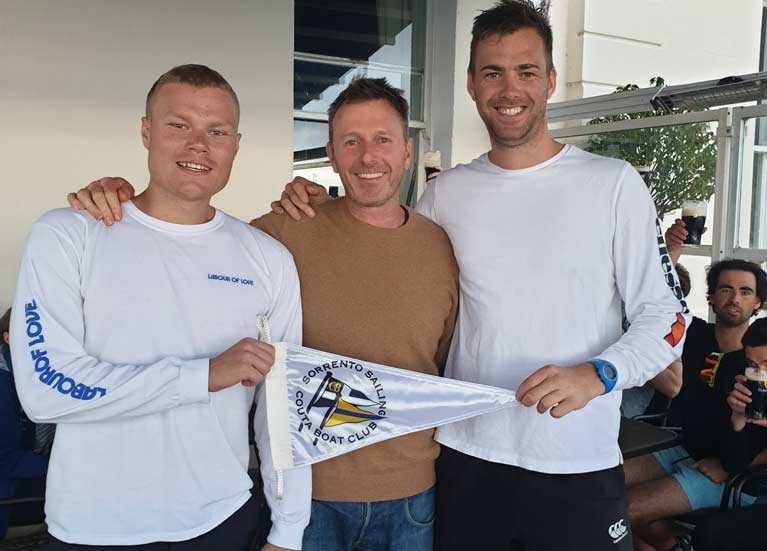 Race organiser Will Byrne (left) with the Sorento Team Racing sailors from Australia
Race organiser Will Byrne (left) with the Sorento Team Racing sailors from Australia
'Curious George' Victorious at Fifth Elmo Trophy Youth Team Racing Event
"Curious George" from the host yacht club emerged the winners of the fifth Elmo Team Racing Trophy sailed this weekend at the Royal St George Yacht Club in Dun Laoghaire Harbour. 22 teams from all over Ireland competed in the event, with most of Ireland's top youth sailors enjoying sailing with and against each other in almost perfect team racing conditions.
Despite a slight delay waiting for wind on Sunday morning, the race team successfully completed almost 120 races over the two days.
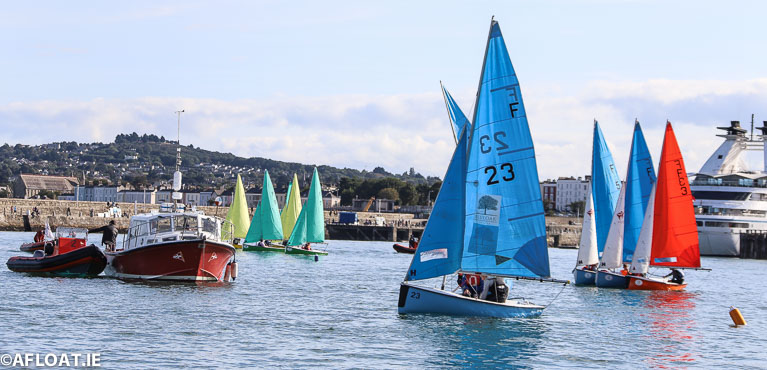 Almost 120 races took place over the two days
Almost 120 races took place over the two days
After the initial round-robin on Saturday, the teams were split into seeded fleets for racing on Sunday. Curious George (Toby Hudson Fowler, Kathy Kelly, Henry Higgins, Isabelle Kearney, Jack Fahy and Emily Riordan) narrowly beat Goats in Boats, led by last years winning captain, Tom Higgins. Showing the competitiveness of the sailing, and how our youth sailors are developing as keen team racers, the next three places had to be decided on count backs, with Morgan Lyttle's 420 Blaze it just edging ahead of George Clooney (captained by Helen O'Beirne) and Atlee Kohl's 3 Amigos. First in the Silver Fleet was Harry Twomey's RCYC team.
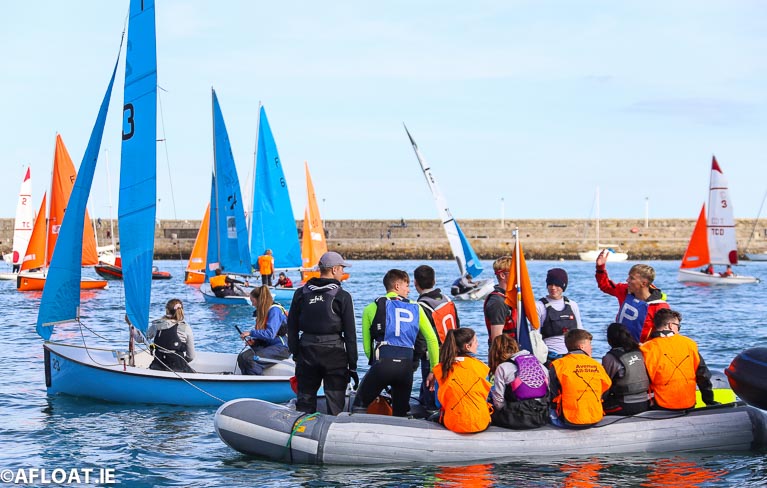 22 teams from all over Ireland competed in the event
22 teams from all over Ireland competed in the event
Raced in four flights for the first time in its 5 year history, the organisers hope this event will grow to a fifth flight and even more teams next year as youth team racing grows around the country.
Royal St George Yacht Club Take Delivery of New Firefly Dinghies
The Royal St George Yacht Club took delivery yesterday of its new fleet of yellow and green Firefly dinghies, just in time for next weekend’s youth team racing event- the Elmo Trophy.
Now in its fifth year, this Dun Laoghaire Harbour based event has been hugely successful at encouraging team racing among school-aged sailors, giving them valuable experience before moving on to college sailing.
Entries are already in from teams from Northern Ireland, RCYC, Academy, the Laser and 420 classes and the RSGYC itself.
All entrants must be 19 or under on December, with 2 team members 16 or under. Entry is open here
Team Racing Programme Launched By Irish Sailing
Following funding success from the BIM FLAG initiative (Bord Iascaigh Mhara Fisheries Local Area Group Development), Irish Sailing is rolling out a Team Racing Programme which aims to reduce the attrition of sailors between the ages of 16 – 30 (especially females) at clubs and training centres throughout the country writes Treasa Cox.
Team Racing is a fun and inexpensive way for clubs to retain young dinghy sailors after they have left the structured environs of class youth racing or the Irish Sailing Training Schemes. With a focus on rules knowledge, boat handling, tactics and teambuilding, the programme will further develop transferable skills and give rise to skilled and competitive racing in a very sociable environment.
The funding has been used to appoint a Team Racing contractor, Rory Martin, and purchase boats and equipment for a travelling roadshow. Rory will meet with clubs to gauge interest and check suitability whilst delivering initial educational and awareness-raising sessions at several locations around the country. Clubs and Training Centres with suitable team racing venues, sailors and volunteers can then choose a date for the roadshow to return and deliver on water coaching and clinics.
Clubs and Training Centres can use the programme to increase membership by using the resources and training offered by Irish Sailing as Rory suggests:
“We are looking forward to visiting clubs and training centres and showcasing team racing throughout the country. The programme, although introductory in nature, aims to encourage clubs and centres to take up the mantle, develop skills, attract participation, encourage volunteers and work to increase membership for underrepresented groups in the sport. We will help as best we can by providing resources, suggesting funding and delivering fun and informative training.”
There are many benefits to team racing as Rory continues:
“Following on from the roadshow Clubs and centres could offer team racing as part of their summer courses or to extend the sailing season into the winter months. Team Racing is already a prominent activity in most Universities, and clubs can utilise the sport to attract student members. Team Racing also leads to upskilling of participants through in-depth rules knowledge which can allow clubs to build on their stock of race officials and training of umpires.”
It is envisaged that many clubs may have fleets of their own boats which could be used for Team Racing. Whilst Fireflies are synonymous with team racing, anything from Optimists to J24s are suitable to get the programme started in your club. For clubs already competent at Team Racing, Irish Sailing can tailor a bespoke programme to your requirements with a team of coaches available to assist.
To register your club’s interest in the roadshow, please contact Rory for more information [email protected]
The Royal St. George Yacht Club in Dun Laoghaire is running week-long youth team racing clinics writes Greg Arrowsmith.
The clinics, starting on the 10th of June and also on the 1st of July are open to everyone, RStGYC members or not, and are aimed at all levels of team racing ability
Team Racing is Ireland's fastest growing form of sailing and is fun, inclusive and competitive for all levels of sailing.
The Royal St. George training is for all ages and ability levels, especially those who feel they may have outgrown the summer courses.
With some of Ireland’s top youth team racers as coaches, these clinics will be a blast ashore and afloat and promise some great weeks of fun.
Places for the clinics are limited and selling fast, so we would encourage you to sign up soon here!
At the end of the summer, the RStGYC will also host the annual Elmo Cup on the 7th and 8th of September this year, the biggest youth team racing event in Ireland.
Schools Team Racing Championships Hat Trick for PBC
After 132 races Presentation Brothers Cork (PBC) were the winners of the Irish Schools Team Racing Championships for the third year in a row.
12 teams qualified for the finals and came from Munster, Leinster and Connaught for the Schull, West Cork event.
PBC was followed closely by CBC and then Schull Sharks. Full results are downloadable below.
Next year the hosts will be the Royal St George Yacht Club on Dublin Bay.
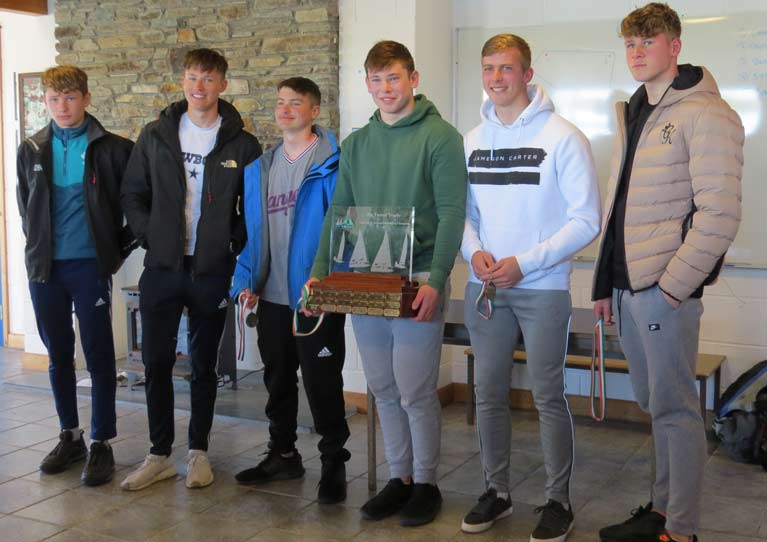 Winners - Presentation College Cork
Winners - Presentation College Cork
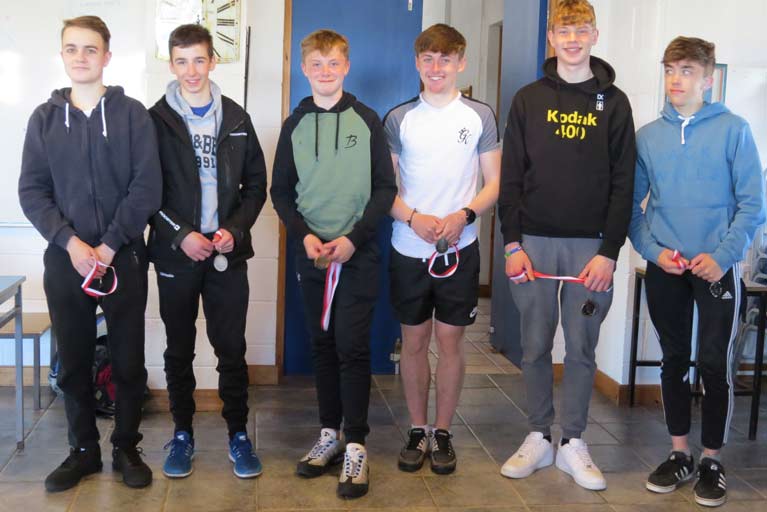 Second - Christian Brothers Cork
Second - Christian Brothers Cork
 Third - Schull Sharks
Third - Schull Sharks
The flight sheet for this weekend's Irish Schools Team Racing Championships at Schull in West Cork has been released. Downloadable below as an Excel file.
With up to 64 preliminary races, the event is using four flights so competing teams won’t have much time between races.
It is hoped to have an Irish Schools Sailing Association meeting after sailing on Saturday, all welcome.
The agenda is to try and build a group to promote schools sailing/team racing, promote coaching clinics, develop umpires and event hosts.
Organiser David Harte from the Fastnet Education Centre has issued a reminder to the 12 competing teams (plus two in reserve) of the championships to be sailed in TR3.6 dinghies at Schull, as Afloat previously reported here.
Gonzaga College in Dublin travel to Roaringwater Bay as Leinster Champions having lifted the trophy at the Royal St. George Yacht Club last month.


























